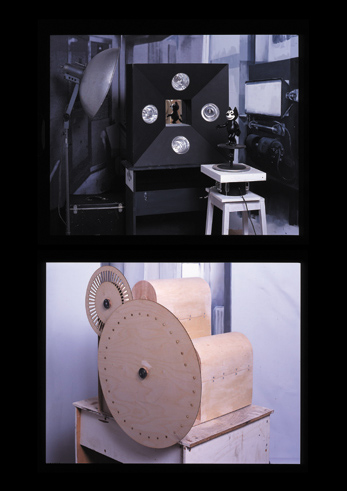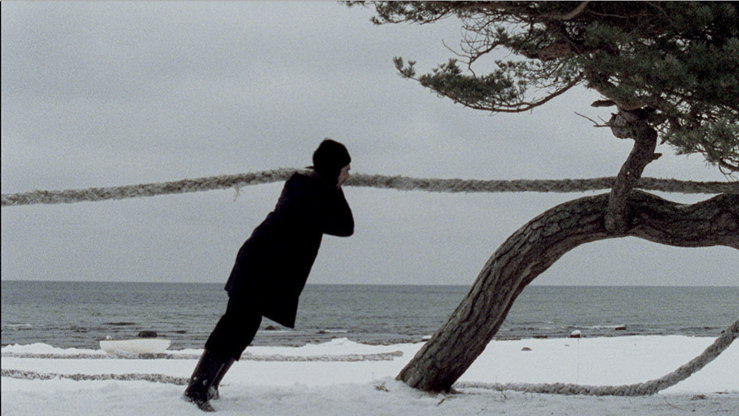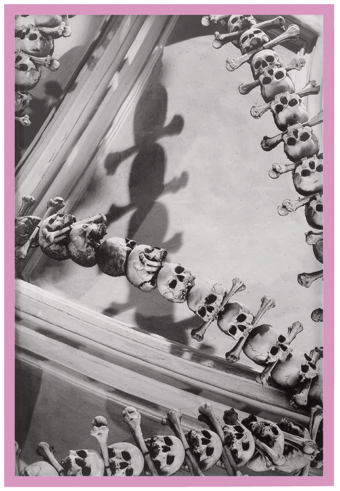Camera Austria International
101 | 2008
- KIRSTY BELL
Mark Leckey: Being in the World - MARK LECKEY
- IAN WHITE
Rosa Barba - ROSA BARBA
- VINCENT PÉCOIL
Swetlana Heger: Walk of Fame - SWETLANA HEGER
- RAINER BELLENBAUM
Change of Dispositif III - ALICE CREISCHER, ANDREAS SIEKMANN
Generali losing a face

Preface
Camera Austria No. 98 kicked off a four-part column in which Rainer Bellenbaum deals with the dispositifs of the cinema and exhibition space and with the associated artistic, dramatic and narrative practices. In this issue he includes the aspect of theatre in his analysis, presenting works by Jeremy Deller and Omer Fast, two positions that can be seen in the context of current debates on artistic strategies of re-enactment.
The change of dispositif in cinematographic, photographic or sculptural installations is also a key theme in the works of the artists invited to contribute to this issue. Mark Leckey’s “Cinema-in-the-Round” picture series developed for Camera Austria goes back to his contribution to the “Kinomuseum” series curated by Ian White at the 2007 Oberhausen Short Film Festival. Instead of the required film programme, Leckey set out there to explore his subjective reactions to certain films (or images and objects) and to look into the phenomenological questions raised by the tricky transition from the two-dimensional picture to the three-dimensional object, or from the still to the moving picture. Kirsty Bell focuses on this complex film oeuvre in her contribution.
Such processes of appropriating images, as discussed by Leckey, also feature in Rosa Barba’s “Western Round Table 2027”. This film installation refers to meetings of famous men who discussed contemporary art, the legacy of modernism and its possible future in a round of talks organised by the California School of Fine Arts in San Francisco in 1949. “Is the implication of Rosa Barba’s 2007 ’round table’ that this conversation was at once already archaeological, cultural dereliction its subject, modernism itself defined as a kind of predictive memorialisation?” Ian White asks in his introductory text, concluding that Rosa Barba’s work “distils what might be its source material into an abstract outside of space and time that defines its terms as a monument and an enigma. […] Self-contained and timeless it is a simultaneously open and closed object, a key to Barba’s practice.”
Read more →Camera Austria International 101 | 2008
Preface
Camera Austria No. 98 kicked off a four-part column in which Rainer Bellenbaum deals with the dispositifs of the cinema and exhibition space and with the associated artistic, dramatic and narrative practices. In this issue he includes the aspect of theatre in his analysis, presenting works by Jeremy Deller and Omer Fast, two positions that can be seen in the context of current debates on artistic strategies of re-enactment.
The change of dispositif in cinematographic, photographic or sculptural installations is also a key theme in the works of the artists invited to contribute to this issue. Mark Leckey’s “Cinema-in-the-Round” picture series developed for Camera Austria goes back to his contribution to the “Kinomuseum” series curated by Ian White at the 2007 Oberhausen Short Film Festival. Instead of the required film programme, Leckey set out there to explore his subjective reactions to certain films (or images and objects) and to look into the phenomenological questions raised by the tricky transition from the two-dimensional picture to the three-dimensional object, or from the still to the moving picture. Kirsty Bell focuses on this complex film oeuvre in her contribution.
Such processes of appropriating images, as discussed by Leckey, also feature in Rosa Barba’s “Western Round Table 2027”. This film installation refers to meetings of famous men who discussed contemporary art, the legacy of modernism and its possible future in a round of talks organised by the California School of Fine Arts in San Francisco in 1949. “Is the implication of Rosa Barba’s 2007 ’round table’ that this conversation was at once already archaeological, cultural dereliction its subject, modernism itself defined as a kind of predictive memorialisation?” Ian White asks in his introductory text, concluding that Rosa Barba’s work “distils what might be its source material into an abstract outside of space and time that defines its terms as a monument and an enigma. […] Self-contained and timeless it is a simultaneously open and closed object, a key to Barba’s practice.”
“Ornamental Remix” is a work by Swetlana Heger that we featured at the “What We Bought” exhibition, our contribution to steirischer herbst 2007. Like Mark Leckey and Rosa Barba, Heger works at the interfaces of art and everyday culture. She is interested in the links and ambivalences between politics and aesthetics, between visual art and architecture/design, and between the seemingly significant and the seemingly insignificant. Beyond that, her work – to which Vincent Pécoil introduces us – also looks into the question to what extent the concept of artistic authorship is still viable, discerning an alarming analogy between what would seem to make up an author’s specific characteristic – his/her style – and the marketing strategies of branding.
In their contribution, Alice Creischer and Andreas Siekmann comment on the fusion of the BAWAG Foundation and the Generali Foundation and the corporate logic that led to this decision. The two artists had curated the exhibition “Die Gewalt ist der Rand aller Dinge” (Violence is at the margin of all things) for the Generali Foundation in 2002, and their knowledge of the institution’s exemplary way of working explains their concern regarding the collection’s continued existence. In our anniversary issue – Camera Austria No. 100 – we already expressed our dismay at how unexpectedly and quickly the rug can be pulled from under outstanding institutions that are funded solely by private means or, inversely, how badly the credibility of (public) institutions can suffer when success is measured purely on the basis of visitor numbers. Again and again, it is therefore necessary to fight to secure the freedom, as Creischer and Siekmann say, in which “artistic production that critically examines its contemporary social conditions” can emerge. We hope that Camera Austria, too, can contribute to this goal. We would like to thank the artists and authors for the pleasant co-operation on this issue and our subscribers and advertisers for their interest, trust and support for our work!
Christine Frisinghelli
Maren Lübbke-Tidow
Entries
Forum
ROBERTA LIMA
NICOLAS FUSSLER
LIEKO SHIGA
ROBERTO RODRIGUEZ
MICHAEL BÜHLER-ROSE
CLAUDIA KUGLER
BRUNO SANTOS
KATHARINA GAENSSLER
Exhibitions
steirischer herbst 2007
Graz
WALTER SEIDL
Zoe Leonard: Fotografien
Fotomuseum Winterthur
Pinakothek der Moderne, München
JOCHEN BECKER
Richard Prince: Spiritual America
Guggenheim Museum, New York
Walker Art Center, Minneapolis
Serpentine Gallery, London
RACHEL BAUM
Roy Arden: Against the Day
Vancouver Art Gallery
Joachim Brohm: Ohio
Galerie für Zeitgenössische Kunst, Leipzig
MAREN LÜBBKE-TIDOW
Die Kunst des Alterns
Stadtgalerie Schwatz in Tirol und arge Kunst Bozen
MARION PIFFER-DAMIANI
Held together with Water. Kunst aus der Sammlung Verbund
Österreichisches Museum für angewandte Kunst/Gegenwartskunst, Wien
ANDREA DOMESLE
Neorealismo. Die neue Fotografie in Italien 1932-1960
PHotoEspañ, Madrid
Fotomuseum Winterthur
Nederlands Fotomuseum, Rotterdam
WOLFGANG BRÜCKLE
Projektion. Bildentwurf und Realität
Kunstmuseum, Luzern
Lentos Kunstmuseum, Linz
ULRIKE MATZER
Stadt Bild Köln. Photographien von 1880 bis heute
Photographische Sammlung/SK Stiftung Kultur, Köln
ROLF SACHSSE
Willie Doherty: Stories
Kunstverein in Hamburg
Städtische Galerie im Lenbachhaus und Kunstbau, München
HIAS WRBA
Bahman Jalali
Fundació Antoni Tàpies, Barcelona
ALBERTO MARTÍN
Taryn Simon: An American Index of the Hidden and Unfamiliar
The Photographer´s Gallery, London
Museum für Moderne Kunst, Frankfurt
Foam_Fotografiemuseum, Amsterdam
KERSTIN STREMMEL
Stan Douglas: Past Imperfect. Werke 1986 – 2007
Württembergischer Kunstverein und Staatsgalerie Stuttgart
RACHEL MADER
Anna Oppermann: Revisionen der Ensemblekunst
Württembergischer Kunstverein, Stuttgart
REINHARD BRAUN
Ganz Unten. Die Entdeckung des Elends
Wien Museum
ROLF SACHSSE
Reality Crossings. 2. Fotofestival Mannheim, Ludwigshafen, Heidelberg
CHRISTOPH SCHADEN
Books
Andrew Phelps: Higley
Kehrerverlag, Heidelberg 2007
MARTIN HOCHLEITNER
Heide Schlüpmann: Ungeheure Einbildungskraft
Stroemfeld Verlag, Frankfurt a.M., Basel 2007
DREHLI ROBNIK
Gerhard Roth: Atlas der Stille
Das Alphabet der Zeit
S. Fischer Verlag, Frankfurt a.M. 2007
RÜDIGER WISCHENBART
Wilhelm Hein: You killed the Underground Film or the Real Meaning of Kunst bleibt … bleibt …
Kali Film Books, Berlin 2007
Passenger Books, Berlin 2007
BARBARA HESS
Peter Gerwin Hoffmann
Verlag der Buchhandlung Walther König, Köln 2007
ULRICH TRAGATSCHNIG
Silke Grossmann: Entfernungsverschiebungen
materialverlag, Hochschule für bildende Künste, Hamburg 2007
NADINE OLONETZKY
Olivier Richon: Provocative Real Allegories
Steidl Verlag, Göttingen 2006
CAROL MAVOR
Katharina Sykora, Ludger Derenthal, Esther Ruelfs: Fotografische Leidenschaften
Jonas Verlag, Marburg 2006
KATHRIN PETERS
Andrea Seier: Remediatisierung. Die performative Konstitution von Gender und Medien
Lit Verlag, Berlin 2007
KATHRIN PETERS
Imprint
Publisher: Manfred Willmann. Owner: Verein CAMERA AUSTRIA, Labor für Fotografie und Theorie.
All: Lendkai 1, A-8020 Graz.
Editors Graz: Christine Frisinghelli, Sabine Spilles, Rebekka Reuter
Editor Berlin: Maren Lübbke-Tidow
Copy editing: Marie Röbl
Translations: Daniela Böhmler, Aileen Derieg, John Doherty, Don Mader, Wilfried Prantner, Josephine Watson, Richard Watts














